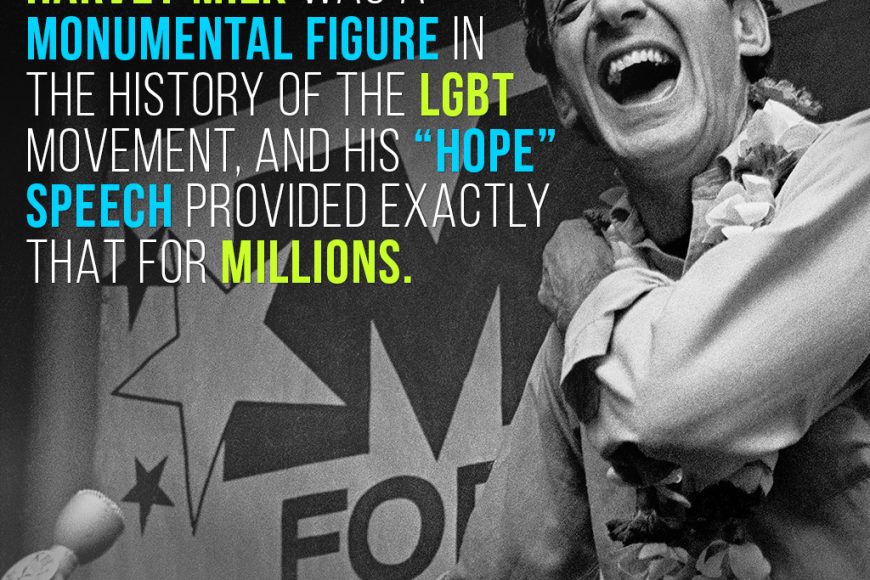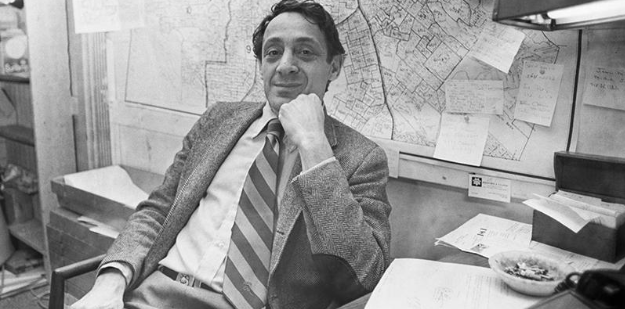
Harvey Milk’s Hope Speech (And How His Speaking and Body Language Changed a Nation)
When you speak with passion and a cause, you can change the course of history. That’s exactly what Harvey Milk’s “Hope Speech” did for millions in the United States’ LGBT community.

The mid-point of the 20th century saw a lot of changes in how we treat one another.
The 1960s saw millions challenging the societal norms that had stayed entrenched for decades. In the United States, the civil rights movement struck crucial blows for equality for all races.
However, the subject of homosexuality still caused contention. Throughout the 1960s and 1970s, the LGBT community experienced continued marginalisation.
Society’s norms had evolved. However, people were still a long way away from being as tolerant and accepting as they are today.
Before 1977, there hadn’t been a single openly homosexual elected official. As a result, many in the LGBT community felt that they didn’t have a voice.
And they didn’t have anybody capable of influencing society on their behalf.
That all changed when Harvey Milk achieved election to the San Francisco Board of Supervisors. In 1978, he delivered a speech so powerful that it caused the societal evolutions that we see manifested today.

What Was Harvey Milk’s Vision?
Born in 1930, Harvey Milk came from a middle-class Jewish family. Growing up, he worked in the family’s store and even participated in the synagogue that they’d founded.
However, Milk noticed that he was a little different to most once he got to high school.
By this point, he already knew that he was gay. However, this was in the 1940s when homosexuality wasn’t a topic that many broached rationally.
Still, Milk started doing his part for his cause early on. In college, he wrote articles encouraging increased diversity and broader thinking. Still, he stayed separated from an emerging gay rights movement and chose to join the navy.
It’s here that discrimination first had a major effect on his life.
He served as a diving instructor for several years. But despite performing admirably, Milk found himself facing official questioning about his sexuality. Upset at this invasion into his private life, Milk chose to resign from his post and moved to New York City. He spent several years working in the city before moving to San Francisco in the 1970s.
He also became a gay rights activist during this period.
Now openly gay, Milk made a number of important political moves on behalf of the LGBT community.
In 1972, he ran for a seat on the San Francisco Board of Supervisors. Though he failed in this first attempt, he put his name on the map. And this leverage enabled him to bring together LGBT people and business owners to unite under a singular cause.
Milk helped to found the Castro Village Association. This group was a collective of mostly LGBT businesses that advocated on each other’s behalf. He also organised the Castro Street Fair to drive more commerce to these businesses.
He ran for office in another failed effort in 1975. But by this time, his skills as a speaker and his influence in the community were undeniable.
In 1977, he once again ran for a seat on the San Francisco Board of Supervisors. His victory in this race marked a massive turning point for LGBT rights in the United States.
A year later, Milk stood on the San Francisco City Hall steps during the San Francisco Gay Freedom Day Parade. There, he delivered a powerful speech that transformed the lives of millions of people.
Here are the four things you can learn from the “Hope Speech”.

Lesson #1 – Your Body Language is a Powerful Tool
In many ways, Milk’s body language during his speech isn’t typical of what you’d expect from a powerful orator.
At times, he stands rather awkwardly. He also reads his speech from a notepad rather than giving it from memory. There’s a certain stiffness to his body language.
But this doesn’t denote awkwardness. The “Hope Speech” is an act of defiance and Milk is, in many ways, barely containing his emotions.
When his voice raises, his body almost swaggers to one side. At various stages of the speech, he points to the crowd when making key exclamations.
Milk then grows into the speech. After a couple of minutes, his body loosens up and his hand balls into a fist. The notepad gets lowered and he engages in a full call to arms. As his message reaches its crescendo, he’s standing confidently and shaking his fist as he speaks.
All of this shows his passion for what he’s saying. This isn’t a well-rehearsed speech with strategic pauses and purposeful body language. Milk allows the occasion to flow through him and he grows into the speech as he talks.
The lesson here is that over-rehearsing your body language could make your speech less impactful. Milk looks natural during the “Hope Speech” because he’s angry. He’s not meant to look calm and collected. His voice rises and his body responds in kind.
That natural aspect of his body language makes him authentic. As a result, his audience hung on to his every word.
Lesson #2 – Look Like the People You Want to Inspire
There’s another clever aspect to Milk’s presentation that often goes underappreciated.
There’s nothing professional about the way he’s dressed during the speech. Despite having recently won election to political office, Milk isn’t in a suit and tie. He’s not talking as a politician.
He’s speaking on behalf of and to inspire the thousands of people that he represents. He’s one of them and it shows in how he presents himself.
Footage from the speech shows Milk in a t-shirt and jeans. As the camera pans out to his audience, you see plenty of people in the same attire.
Milk understood that connecting with his audience involved showing them that he’s one of them. The suits, ties, and professional clothing were for the office. This was Milk’s chance to stand in front of supporters and peers to say something important.
Milk wanted to inspire other young homosexuals into action. Because he looked like the people he spoke to, they more readily accepted that message.
Lesson #3 – Start Strong
In the “Hope Speech”, Milk had his audience in the palm of his hand before he spoke. In fact, he spends the first few seconds in a celebratory mood. He raises his hands in the air and encourages his audience to cheer. He wants them to feel jubilant by the time he delivers his opening line:
“My name is Harvey Milk and I’m here to recruit you.”
It’s to the point and elicits a massive response. Milk tells his audience the exact purpose of the speech with his opening line. He has a cause and he wants everyone in the audience to join him and show their support.
Whipping the audience into a frenzy beforehand achieves a visual effect that viewers get caught up in. This, in turn, makes his opening line even more triumphant.
Milk then jumps straight into a joke, which keeps the mood buoyant and maintains the strong start.
A strong start is so important for a speaker. You want to grab the audience’s attention from the moment that you open your mouth.
Lesson #4 – Pepper Your Speech With Your Experiences
For the most part, Milk’s speech focuses on the importance of electing LGBT leaders and dispelling myths. He also focuses on some of the political issues of the day. These included a perceived shift to the right in America’s political climate and issues related to South Africa.
These were all important points to make. However, they may have struggled to connect with an audience without some emotional weight behind them.
That’s why Milk draws on his own experiences to relate his story to the words that he speaks.
For example, towards the end of his speech he says:
“I can’t forget the looks on faces of people who’ve lost hope. Be they gay, be they seniors, be they blacks looking for an almost-impossible job, be they Latins trying to explain their problems and aspirations in a tongue that’s foreign to them. I personally will never forget that people are more important than buildings.”
This personal experience lends weight to Milk’s political arguments. He identifies with his audience and helps them to see who really benefits from the changes he wants to bring about.
That added emotion is a crucial part of the “Hope Speech”, just as it should be in yours. You’ve experienced things that can benefit your audience. Draw on those experiences to strengthen your speech’s key threads.
Learn How to Inject Passion into Your Speaking
Unfortunately, Harvey Milk’s story ended in tragedy. Just a few months after delivering the “Hope Speech”, former Supervisor Dan White assassinated Milk.
But his words lived on. In the “Hope Speech”, he created a clarion call for the LGBT community. And it inspired people to keep pushing for equality and greater leadership in the decades following his death.
Harvey Milk’s passion and personal experiences helped to fuel an entire movement.
Speakers Institute can help you to harness the same techniques that he used to inspire others.
Would you like to find out how? Try doing the following today:
- Take me to GREENROOM. The #1OnlineHub connecting you to the world’s leading Influencers, Training and Curriculum.
- For information on dates and times of our live events, just go here: LIVE EVENTS.
